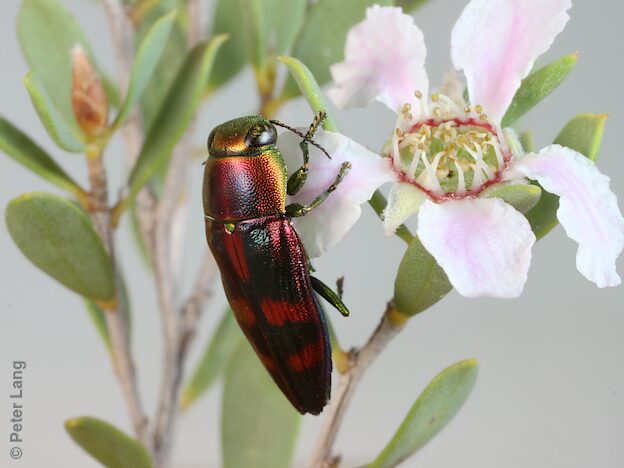
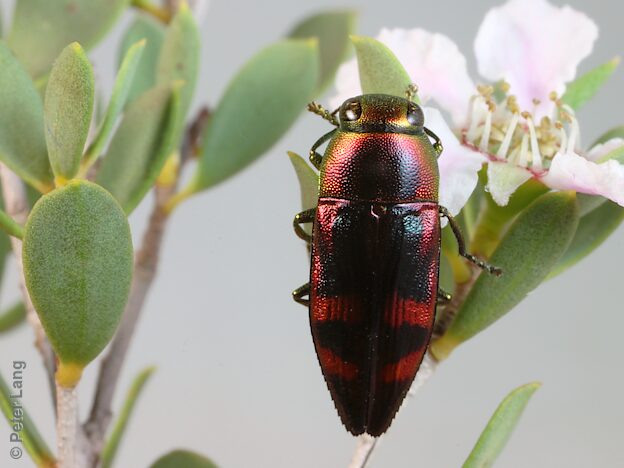
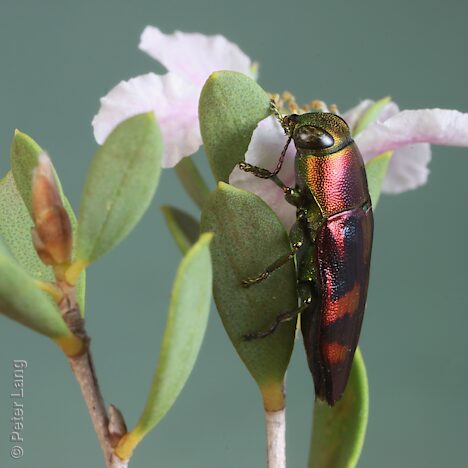
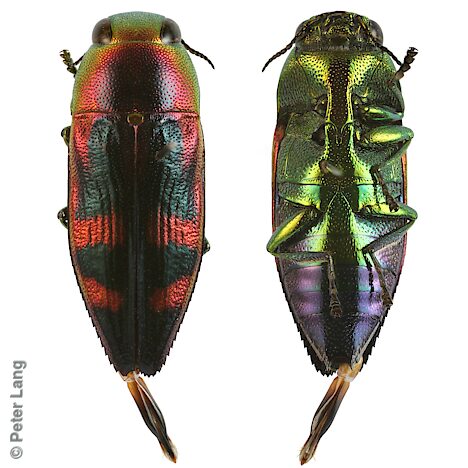
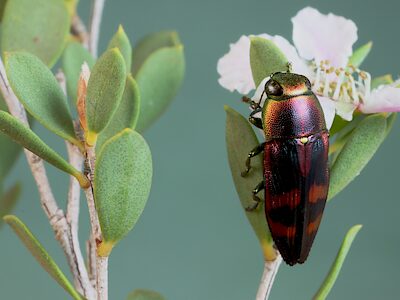
size¹:
×
4.1 mm





| male | female | |||||
|---|---|---|---|---|---|---|
| L1 | 10.3 | 10.15 – 10.4 | n = 2 | 11.5 | 10.5 – 12.05 | n = 3 |
| L2 | 10.1 | 10 – 10.1 | n = 2 | 11.2 | 10.2 – 11.7 | n = 3 |
| W | 3.8 | 3.8 – 3.9 | n = 2 | 4.3 | 3.85 – 4.5 | n = 3 |
| Legend | L1 | length from clypeus/frons to elytral apex (mean, range, sample size) |
| L2 | length from anterior of edge of eyes to elytral apex | |
| W | maximum width with elytra fully closed |
Distinguished by the fiery red background colour of the elytra and coppery sides of the pronotum. Differs from M. pretiosa by its more tapered shape, and the anterior dark fascia on the elytra extending closer to the anterior margin but not as close to the lateral margins.
Melobasis pyritosa was long regarded as a synonym of Melobasis sexplagiata (Laporte & Gory, 1837) following Carter 1923b. Initially on these pages (June 2020) it was included under that name, but B. Levey (pers. comm., July 2020) subsequently identified images of PL2624 (shown here) as M. pyritosa.
The Murray Region (MU) occurrence is a Tepper collection made in 1874 from the Bremer River at Salem, which is south of Callington on the eastern edge of the Mount Lofty Ranges.
In south-west WA, McMillan 1950b inferred that adult M. pyritosa were emerged and active between June and October, but it appears that only non-emerged beetles were actually collected (i.e. ecdysed or 'emerged' from pupal cuticle, but not emerged from host plant). Previously McMillan 1950a stated that 'the mature beetle remains in the tree from early June until late September' and that he had no knowledge of the adult beetles being 'taken alive in a free state'.
| Legend | P.J.Lang collection vouchered records | |
| other private collection or museum specimens, or sightings |
|
|
|
|
|
|
|
|
|
|
|
|
|
||||||||||||||||||||||||||||||||||||||||||||||||
|
|
|
|
|
|
|
|
|
|
|
|
|
||||||||||||||||||||||||||||||||||||||||||||||||
| Jul | Aug | Sep | Oct | Nov | Dec | Jan | Feb | Mar | Apr | May | Jun |
| Legend | ||
9 | number of active beetles, actually recorded in that quarter-month | |
| actual count > 1 (median) | ||
| actual count <= 1 (median) | ||
| beetles | sites | SA regions¹ | family | position on host plant | ||
| Leptospermum coriaceum | 3 | 3 | EP, SE | M |
| Legend | beetles | count of beetles collected from, or sighted on, host plant taxon |
| sites | count of major sites (unique 10 km grid cells +/- some distinct approximate localities) | |
| Plant names in green are hyperlinked to a matching host species page with plant photos. | ||
| Code | beetles | % | host plant taxa | |
| M | Myrtaceae | 3 | 100% | 1 |
| position | beetles | sites | |
| on flowering plant | 3 | 3 |
Tepper 1887 reported that M. pyritosa frequented 'Cassia eremophila [=Senna artemisioides], a yellow-flowered leguminous shrub in mallee scrubs'. However, recent collections in SA and Victoria have only been from white-flowered nectar-rich flowers of Myrtaceae species, especially Leptospermum coriaceum.
Melobasis pyritosa is well known in south-west WA for breeding in the bark of Flooded Gums Eucalyptus rudis. It was very common and widespread there based on McMillan 1950a who expounded its distribution and wrote that: 'in practically every flooded gum (Eucalyptus rudis) examined, I have cut out from the bark a very beautiful little jewel beetle known as Melobasis sexplagiata ..'. (B. Levey (pers. comm., Apr 2024) advised that the species breeding in E. rudis previously regarded as M. sexplagiata, is in fact M. pyritosa.)
According to McMillan 1950a 'tunnels formed by the larvae usually run down the tree, and the beetle is usually found at the bottom of these tunnels, with its back to the trunk and head pointing up the tree. ..The beetle remains in the tree from early June till late September, .' He states 'The only way I have collected this beetle is by cutting it from its breeding place, the bark of the flooded gum. .. Select a gum that has plenty of rough bark. The best place to start is on the side away from the prevailing weather. .. looking for dead patches in otherwise healthy bark.' Further details on the life cycle and larval stages are presented in McMillan 1950b.
Significantly, Melobasis pretiosa, - q.v. which is in the same species group, has also been found in SA to breed in the thick bark of a related Eucalypt.
| ¹ Legend | regions | SA State Herbarium regions (map) EA: Eastern, EP: Eyre Peninsula, FR: Flinders Ranges, GT: Gairdner-Torrens, KI: Kangaroo Island, LE: Lake Eyre, MU: Murray, NL: Northern Lofty, NU: Nullarbor, NW: North-Western, SE: South-Eastern, SL: Southern Lofty, YP: Yorke Peninsula |
| size | The ellipse is the correct size when printed, indicative on a desktop screen, and likely to be wrong on a mobile device. |